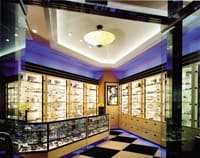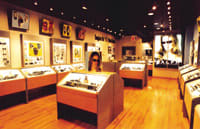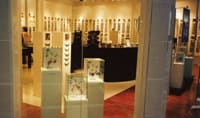Store Wars
In the face of retail acquisitions and launches, competition in the sunglass arena is getting fierce. Here's a look at the facts and how the changes could impact the optical independent
By Erinn Morgan
Illustrations by Zachary Pullen
The recent happenings in the sunglass retail sector have turned the business upside down. Luxottica purchased Sunglass Hut's 1,962 stores and subsequently changed the chain's product mix significantly. In a move to remain competitive after losing its 26 percent market share in Sunglass Hut stores, Oakley expanded its retail account list and purchased a sunglass chain itself--the acquisition of 40-store Iacon was completed in November 2001.
Additionally, luxury goods powerhouse Moët Hennessy Louis Vuitton (LVMH) was at press time reportedly in the process of selling its stateside six-store sunglass chain, Solstice, to a company affiliated with Sàfilo Group.
The merchandising shift made in Sunglass Hut has affected many suppliers, causing them to scramble in a search for new homes for their brands. They say pressures from licensors to meet projections are intense in a tighter market, creating an even more stressful quest for new business outlets.
The trickle-down effect has even created repercussions for factories manufacturing sunwear--layoffs in China have been substantial, and the industry there is still reeling from dramatically decreased business.

This is, however, a familiar feeling to the people occupying the layers of the optical business: Luxottica's purchase of LensCrafters produced the same ripple effect years ago.
Still, the questions are on the tip of more than a few tongues. Where will suppliers find new outlets? Will they all survive the shuffle? How will the new competition--Sunglass Hut under the leadership of Luxottica, Iacon (charged for growth with a capital infusion from Oakley), and Solstice--effect the optical retail market which has become increasingly committed to selling sunwear? Does the optical retailer fit into the evolving landscape?
Some say that now more than ever is the best time for dispensers to increase brand collections simply because lines are looking for new outlets.
DIFFERENTIATION IS KEY
Still, a cautious eye is prudent, as new and old competitors could be opening doors nearby. The key, say the experts, is differentiation in merchandising and commitment to the sunwear category.
"We don't need to sit down and cry, but we do need to commit to selling sunwear," says Steven Schubach, president of the Standard Optical chain in Utah, which has recently opened two sunglass-only retail stores. "Optical has given this business up to others who just don't do it as well."

Certainly, optical professionals have an advantage that sunglass stores have overlooked: An educational prowess about the technical details, performance eyewear, lenses, and high-quality goods. Perhaps it's time to use this to your own advantage.
WHAT HAPPENED?
The first shockwave came when Luxottica's acquisition of Sunglass Hut was announced. The optical giant purchased the 31-year-old behemoth chain last year for $653 million in cash, including the assumption of debt.
"We believe that there is a big future for the sunglass business in America, and Sunglass Hut is clearly the leading retail authority and a successful chain," says Kerry Bradley, chief operating officer of Sunglass Hut North America, of the purchase.
"We have leading brands such as Ray-Ban. It makes sense to combine both and capitalize on the growth in sunglass business in North America."
The deal included 1,962 Sunglass Hut locations worldwide; 1,304 of them sunwear specialty stores, 430 combination sunglass/watch stores, and 228 watch-only locations.
"Our current combined store total is roughly 1,650," says Bradley, who noted the chain was reorganized, resulting in the closing of stores. "We will be growing that in years to come in both sun and watches. Cross-merchandising is also very important to us; we have watches as an accessory in our sun stores and vice versa."
Luxottica also owns LensCrafters, which operates 864 stores in the U.S. and Canada. "The acquisition of Sunglass Hut is the next step in our strategy to penetrate the retail market in North America," reports Leonardo Del Vecchio, Luxottica's chairman and the firm's founder.
He said the acquisition "is the natural outcome of our strategy to strengthen our presence in the sun segment, which we started two years ago with the Ray-Ban acquisition."
Similar to the strategy put in place at LensCrafters, Luxottica moved quickly to move more of the product mix to reflect its own brands. "There is certainly more Luxottica product in Sunglass Hut than before, but there is room for others. We do not have a 100 percent Luxottica vision for Sunglass Hut," Bradley says.
|

|
|
|
Iacon's Occhiali de Sole is the group's high-end component |
|
THE IMPACT
One of those companies most affected originally by the change was Oakley, who had commanded a large presence at Sunglass Hut.
In fact, 19 percent of Oakley's product sales in the last fiscal year were done through the chain.
In its recovery effort, Oakley began an aggressive campaign to increase its retail stronghold in other outlets such as Footlocker and Nordstrom. The performance eyewear company also decided it was time to buy its own piece of retail real estate--the purchase of 40-store Iacon was its next move.
The chain, started 20 years ago by now-president Jeff Obstfeld, operates 43 stores in 10 states, mostly based in the Southwest. Iacon's store brands include three concepts: Sunglass Designs, which is more mainstream product oriented and priced from moderate to mid-range; Sporting Eyes, which includes performance eyewear from $25 to $400; and Occhiali de Sole, with an upscale branded fashion focus.
Two-thirds of the stores are kiosks and one-third are inline stores in "A" malls. As of its fiscal year, which ended August 30, 2001, Iacon had brought in $15 million in sales, 26 percent of which was Oakley products.
|

|
|
|
Sunglass Hut, purchased by Luxottica, is a powerhouse in the sunwear industry |
BUSINESS PLAN
"We plan to keep everything the same with Iacon," says Gar Jackson, a spokesperson for Oakley. "They have a good model for business, and we can add capital to facilitate further growth." In fact, Oakley plans to keep the current merchandising mix in place, even selling Luxottica product.
According to Obstfeld, who will remain as president of the wholly owned Iacon, "We are positioned to be in the boutique end of the sunglass business, addressing customer needs with three concepts. I believe we complement Sunglass Hut in the marketplace, filling niches they don't."
Oakley recently announced that it has also inked an agreement to debut Oakley in-store concept shops in four California and one Hawaii Macy's West locations. The shops will include eyewear, footwear, apparel, and watches, company representative say.
While all Oakley products were originally taken out of Sunglass Hut, Luxottica and Oakley have recently announced that they have sorted out their differences and have signed an agreement to get some Oakley styles back in the chain.
In addition to the ruckus caused by these major acquisitions by Luxottica and Oakley, LVMH has created quite a stir with the launch of its own retail chain, Solstice.
According to industry insiders, however, LVMH is reportedly selling its interest in Solstice to Sàfilo Group, which has a roster of designer sunglass brands that fit perfectly into the chain's high-end strategy.
With the financial fuel of such a huge company behind it, this new store group--which already has at least six doors open in five states (New Jersey, North Carolina, Florida, California, and Virginia)--could make its mark in a competitive market.
THE AFTERSHOCK
The effects of these major retail events are widespread. The increased competition from powerful players with big pockets for expansion has certainly changed the retail landscape in sunwear.
The fact that these companies are also manufacturers means that some other lines of sunwear are now out of a home. This has created difficulties for suppliers and factories alike.
Some suppliers report that one of the toughest aspects of this situation has been communicating and trying to make sense of it to the licensors of fashion and sports brands.
Additionally, some factories producing sunwear have been greatly affected. According to several sources, thousands of people have been impacted by layoffs at facilities around the world. One supplier reports that on a recent trip to China he saw 20 to 25 percent fewer workers in some of the factories there.
One effect that some fear is that certain brands will have to look to new avenues--including lower-price outlets and Websites--to maintain business, thus lowering the bar on the caché of those names.
"There was a time when we sold a lot of Ray-Bans, and then their business got to be so broad," says Gary Scheer, president of Alveron Optical, which has seven locations in Arizona. Scheer notes that he remembers many years ago the impact that the expansion of distribution to drug stores had on optical retailers.
Luxottica has since brought Ray-Ban out of distribution trouble, but many wonder if this same problem could happen to other brands today, given the retail climate in sunwear.
|

|
|
|
Solstice is expected to move from LVMH to Sàfilo, creating a powerful contender in the industry |
|
THE AFTERMATH
Where does all of this leave the eyecare professional who sells sunwear or is seriously considering it?
Interestingly, some experts say dispensers who are committed to sunwear, and have a solid strategy of differentiation from the chains, could be successful in this climate.
"We are looking to differentiate ourselves from Sunglass Hut and the others," says Standard Optical's Schubach. "We are looking to differentiate with performance sunwear sold by highly trained salespeople with optical knowledge as opposed to the order takers that dominate sunglass places."
Schubach currently has two sunglass stores under the Rocky Mountain Eyeworks name, and he says that the company plans to open more in the future.

"Our position is that sunglasses are a $3 billion business. Two billion is sold by retailers and one billion is sold by the traditional optical retailers. We hope to see a switch to a situation where it is 50/50, and our goal is to try to make that happen," Schubach says.
Others agree that defining a niche can make your sunglass business viable in a competitive environment. Jeff Brody owns two profitable sunglass-only stores, Sunglass City, in San Anselmo and Fresno, Calif. He also operates a Website, www.sunglasscity.com, that has seen a 400 percent increase in business since its launch three years ago.
"I don't see the acquisitions and expansions affecting my business," he says. "Part of what I do is retail and part is off-price. The retail includes major brands. But the discounted products bring in people from a 30-mile radius," says Brody.
"We have been around for 16 years, have a good reputation, and people make it a destination. I think I don't compete with regular sunglass stores at all because of that," he says.
The final point: There are many suppliers with excellent brands that are actively looking for a new retail foundation.
If optical dispensers are ready and willing to commit to the sunwear category, and willing to face the competition, now is one of the best times to do it. There are brands available which could help build a successful sunglass business.
Researching the options, educating oneself about the undiscovered niches in the marketplace, and positioning a merchandise mix accordingly--all of these factors could lead to owning a successful optical business in competitive times.



